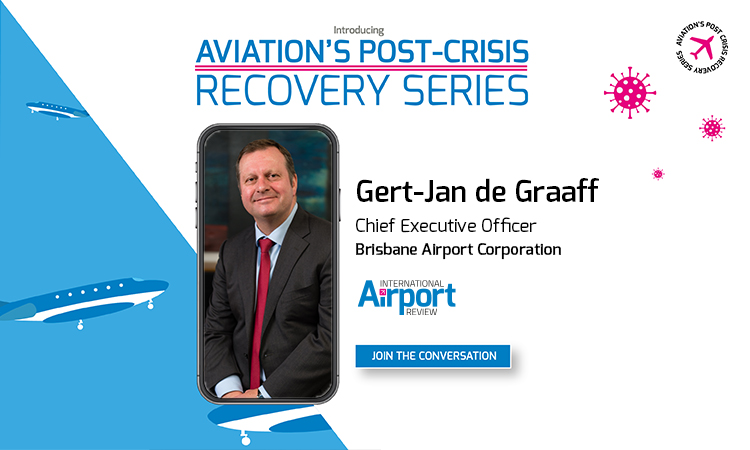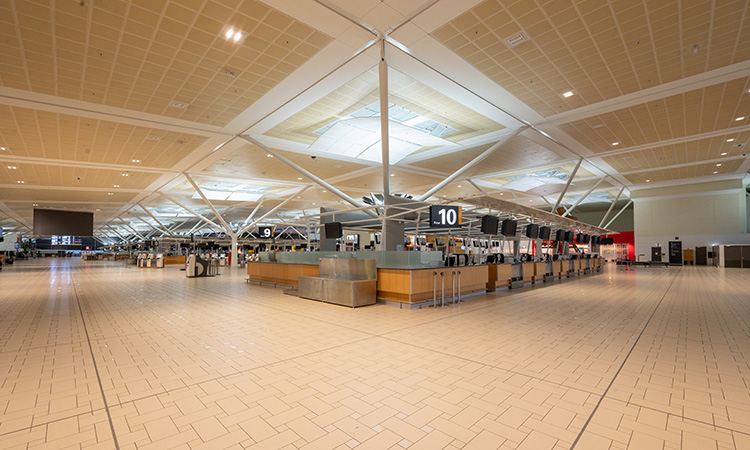Aviation’s Post-Crisis Recovery Series: Brisbane Airport
- Like
- Digg
- Del
- Tumblr
- VKontakte
- Buffer
- Love This
- Odnoklassniki
- Meneame
- Blogger
- Amazon
- Yahoo Mail
- Gmail
- AOL
- Newsvine
- HackerNews
- Evernote
- MySpace
- Mail.ru
- Viadeo
- Line
- Comments
- Yummly
- SMS
- Viber
- Telegram
- Subscribe
- Skype
- Facebook Messenger
- Kakao
- LiveJournal
- Yammer
- Edgar
- Fintel
- Mix
- Instapaper
- Copy Link
Posted: 26 February 2021 | Gert-Jan de Graaff | No comments yet
In the latest instalment of our exclusive series, Gert-Jan de Graaff, CEO of Brisbane Airport Corporation (BAC), explains how quick thinking has been central in adapting to the challenges of the pandemic, and that there is a glimmer of hope for recovery on the horizon.


The COVID-19 pandemic has been completely unprecedented in its impact on the aviation industry. How has it impacted Brisbane Airport?
The COVID-19 pandemic is undoubtedly one of the toughest challenges that the aviation industry has ever faced. Almost without exception, every business in aviation is suffering huge losses.
The situation for aviation in Australia – a land locked entirely by sea – is quite unique when compared to anywhere else in the world, as we have shut our international borders completely throughout the pandemic.
Strict international passenger caps have been in place, limiting the number of repatriated Australians entering hotel quarantine. For the state of Queensland, this number has been capped at 500 international passengers a week and, more recently, increased to 1,000.
The impact that COVID-19 has had on Brisbane Airport (BNE) and our partners has been significant. Pre-pandemic, international traffic accounted for 25 per cent of passengers at Brisbane Airport, 50 per cent of Brisbane Airport Corporation’s (BAC) revenue and 50 per cent of Brisbane Airport’s workforce, which was estimated at 24,000 before COVID-19.
Brisbane Airport’s passenger numbers for the 2020 calendar year were still 66.6 per cent down when compared to 2019, marking a 26-year low”
With international passenger numbers down by 98 per cent, our in-terminal retailers who rely so heavily on foot traffic have been forced to close, and thousands of workers who support international movements have been stood down or made redundant.
While the international border closure has protected our domestic market, Brisbane Airport’s passenger numbers for the 2020 calendar year were still 66.6 per cent down when compared to 2019, marking a 26-year low. Our strongest market throughout COVID-19 has been intrastate travel, with more Queenslanders choosing to travel within their own state to avoid potential domestic border closures.
The impact of the pandemic also resulted in a range of organisational changes at Brisbane Airport Corporation to better align teams and consolidate operations.


Credit: Brisbane Airport
What immediate changes did you have to make in response to the pandemic, and what did you find the hardest problem to tackle?
We immediately re-scaled our planned capital works programme to better reflect and align with lower passenger forecasts for the coming years. With the significant decline in flights and passengers due to COVID-19, a decision was made to re-evaluate and focus on critical project activities in the short-term.
Our current focus is on streamlining airport operations, enhancing the passenger experience and maintaining compliance with industry standards”
Our current focus is on streamlining airport operations, enhancing the passenger experience and maintaining compliance with industry standards.
From an operational perspective, we also consolidated wherever possible, particularly within the International Terminal, where passengers and movements were more or less halted.
For Brisbane Airport Corporation, we immediately structured the company for crisis and, now, recovery – using a cross-functional approach that allowed us to get things done quickly and allow everyone to focus on what’s important.
BAC’s approach to COVID-19 has been, largely, divided into three phases: Crisis; Response; and Recovery. At each step through these phases, we endeavoured to bring a thoughtful, strategic approach to all aspects of our business to ensure that we managed not only the financial impacts, but also the broader impact of COVID-19 on the airport’s role in our community, and on the many thousands of people who rely on our facilities and services for their livelihoods.
What initiatives are you focusing on during 2021 to rebuild passenger confidence?
Passenger safety and wellbeing are always our top priority.
At Brisbane Airport, we have introduced a range of measures through our COVID-Safe Plan to create a safe environment for everyone. The plan was developed in collaboration with the Queensland government to ensure practical and effective measures were implemented to ensure the safety of everyone at the airport.
We have increased the frequency of cleaning throughout the airport, especially in high touch areas such as counters, touch screens, security screening, lifts and travellators, and are using hospital grade cleaning products. Hand sanitiser units and antibacterial wipe dispensers have been installed throughout the terminals, buses, car parks and passenger pick-up areas.
Social distancing signage and floor markers are in place throughout the terminals, and regular audio announcements are made to remind passengers to practice social distancing.
An agreed inter-agency COVID-19 response plan has been developed between BAC and state and federal government departments to set out specific operational instructions and infection control processes”
An agreed inter-agency COVID-19 response plan has been developed between BAC and state and federal government departments to set out specific operational instructions and infection control processes. Currently, masks are mandated for all travellers and visitors within the terminal precincts.
Brisbane Airport has received international endorsement for its COVID-Safe practices, with Airports Council International (ACI) awarding it with the Airport Health Accreditation (AHA). The accreditation assesses an airport’s facilities and hygiene protocols across all areas of the passenger journey (from the car park to the physical boarding of an aircraft), in adherence to international aviation recommendations.
What other exciting projects/developments are in the pipeline at Brisbane Airport to help cope with increased passenger numbers once air travel begins to pick-up again?
The economic impacts of COVID-19 have meant that all non-maintenance related developments have been paused.


Credit: Brisbane Airport
There have, however, been a couple of exciting additions to our Domestic Terminal that were committed as part of the $40 million redevelopment that commenced in mid-2018. In December 2020, we opened our brand-new LEGO Store on Level 2. We also opened The Aviary – an exquisite café and bar offering table service and an exceptional view of the tarmac.
The most significant project that will help Brisbane Airport to cope with increased passenger numbers is our new runway, which opened in July 2020. The importance of Brisbane’s new runway cannot be overstated, particularly now as we work towards recovery.
This runway is so much more than 3.3km of asphalt. It is an enabler of social, cultural and economic growth. We often talk about the fact that, by 2035, the runway will generate 7,800 new jobs and an additional AUS$5 billion in annual economic benefit to the region. I think that, as the world grapples with the COVID-19 situation, the importance of the runway in this moment lies in allowing Brisbane and Queensland to support industries in recovery.
There are a range of projects in the pipeline that have been paused due to lower passenger numbers and the current economic uncertainties. These include a new multi-level car park at the International Terminal, which will cater for growing passenger numbers once international travel returns.
We are also powering along with the BNE Auto Mall, which is the largest non-aviation project that Brisbane Airport has undertaken to date. BNE Auto Mall will revolutionise the way that people buy and experience vehicles, with flagship automotive dealerships alongside experience centres, exhibition and conference facilities, hotels, event areas, commercial offices and associated amenities. The heart of the precinct will be a 2.3km performance track that will feature a 4WD demo course, manoeuvring course, low-friction handling circuit, kick plate, skid pan and a dedicated slalom area.
Are there any initiatives that you have implemented during the COVID-19 pandemic that you will permanently integrate into your airport’s strategy, even once the crisis has passed?
Throughout the COVID-19 pandemic, our focus has been on streamlining airport operations, enhancing the passenger experience, maintaining compliance with industry standards and fostering greater collaboration across the business.
The upgrades will provide an added and enhanced layer of security, while also offering a streamlined, non-invasive screening process for passengers”
We have committed to the Australian government-mandated screening equipment upgrade across both terminals, bringing Brisbane Airport’s security screening standards in line with major airports around the world. Through this upgrade, all metal detectors will be replaced with body scanning equipment, and carry-on baggage screening conveyors will be replaced with computed tomography (CT) scanning systems. The upgrades will provide an added and enhanced layer of security, while also offering a streamlined, non-invasive screening process for passengers.
Through collaboration came a commitment to ensuring that Brisbane Airport was doing all it could to support our partners throughout the pandemic. In April 2020, we launched ‘BNE Marketplace’ – an eCommerce solution that continues to support our retailer partners by providing an online channel to deliver ‘virtual pax’ during a time where foot traffic within the International Terminal is down by around 98 per cent.


Credit: Brisbane Airport
With domestic travel still occurring, we have been able to keep most of our food and beverage (F&B) partners within the Domestic Terminal operating through an approved COVID-Safe Plan. They have all incorporated digital signage, sanitation stations, social distancing stickers, entry/exit zones and maximum patron stickers.
Throughout the COVID-19 pandemic, Brisbane Airport worked closely with its business partners to keep the flow of insights and intelligence going in both directions. We delivered a Business Partner Portal to ensure that those most in need had COVID-related information and resources available when needed. The Business Partner Portal remains a critical communications and stakeholder engagement platform that provides a single source of truth for airport partners.
What business activity are you forecasting for Brisbane Airport/ what is your business outlook?
While we are seeing a glimmer of hope with slowly growing schedules and passengers here at Brisbane Airport, full recovery to pre-COVID-19 passenger numbers will take many, many years”
Current global uncertainties make it a challenging environment for predictions and business forecasting.
While we are seeing a glimmer of hope with slowly growing schedules and passengers here at Brisbane Airport, full recovery to pre-COVID-19 passenger numbers will take many, many years.
The work that was undertaken with the federal and state governments in January 2021, creating an interagency agreement to establish green lane flights between New Zealand and Brisbane, has set the foundation for future green lane or ‘bubble’ zones to be established with other jurisdictions in the future.
It is an important step to re-establishing international aviation activity, and we will continue to work closely with all relevant bodies to ensure that we are ready to go for future two-way travel bubbles.
We hope that, with a successful vaccine rollout across the globe, we will be able to welcome more green lane flights to Brisbane Airport.
While COVID-19 continues to present much uncertainty in terms of what the short-term future holds, I am confident in the resilience of the aviation industry and the adaptability of our team.
Throughout the COVID-19 crisis, the Brisbane Airport Corporation team has met all challenges with courage, care, collaboration and creativity.
We have kept the lights on and our airfield fully operational during the darkest of days, ensuring essential health, repatriation and freight flights could continue.
With the recent opening of our new runway giving us the most efficient runway system in Australia, the next five years for Brisbane Airport is, without a doubt, centred on being the most important driver and catalyst for the city and state as we move together towards industry and economic recovery.
Gert-Jan de Graaff was appointed to the position of Chief Executive Officer of Brisbane Airport Corporation Pty Ltd (BAC) in June 2018. De Graaff has more than 20 years’ experience in leadership roles at major airports around the world. He started his career in airport management in 1995 with Amsterdam Airport Schiphol (AMS) in The Netherlands where he had a number of roles. These included management positions in the commercial, finance and strategic departments.
Related topics
Aeronautical revenue, Airport construction and design, Airport crisis management, Airside operations, Aviation's Post-Crisis Recovery Series, COVID-19, Non-aeronautical revenue, Passenger experience and seamless travel, Passenger volumes, Regulation and Legislation, Retail, Safety, Terminal operations, Workforce
Related airports
Related organisations
Airports Council International (ACI World), Brisbane Airport Corporation (BAC)


















